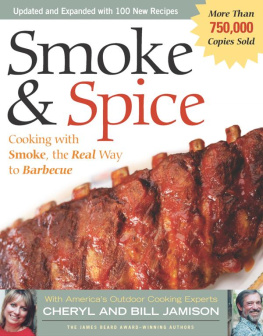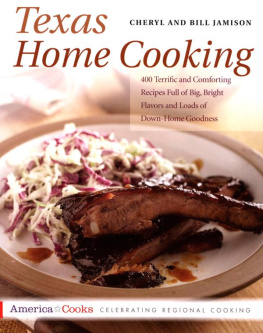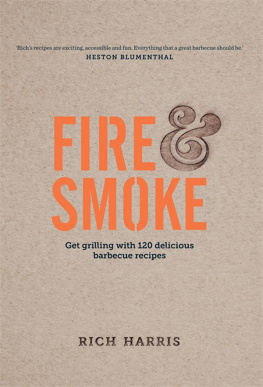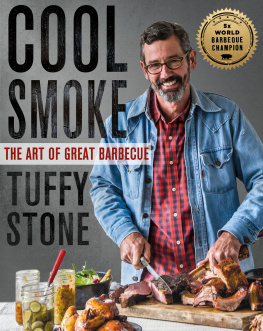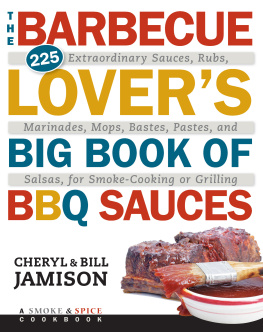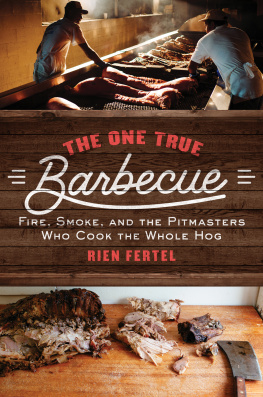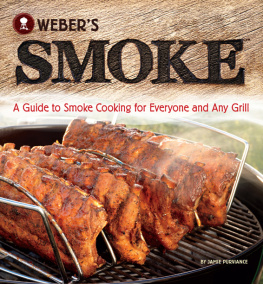The Harvard Common Press
535 Albany Street
Boston, Massachusetts 02118
www.harvardcommonpress.com
Copyright 2003 by Cheryl Alters Jamison and Bill Jamison
All rights reserved. No part of this publication may be reproduced or trans
mitted in any form or by any means, electronic or mechanical, including
photocopying, recording, or any information storage or retrieval system,
without permission in writing from the publisher.
Printed in the United States of America
Printed on acid-free paper
Library of Congress Cataloging-in-Publication Data
Jamison, Cheryl Alters.
Smoke & Spice : cooking with smoke, the real way to barbecue / Cheryl
and Bill Jamison.Rev. ed.
p. cm.
ISBN 1-55832-261-2 (hardcover)ISBN 1-55832-262-0 (paperback)
1. Barbecue cookery. 2. Smoked foods. 3. Spices. I. Title: Smoke and spice.
II. Jamison, Bill. III. Title.
TX840.B3.J36 2003
641.5'784dc21 2003000507
ISBN: 978-1-55832-262-2
Special bulk-order discounts are available on this and other Harvard
Common Press books. Companies and organizations may purchase books
for premiums or resale, or may arrange a custom edition, by contacting
the Marketing Director at the address above.
19 20 21 22 23 24 25 26 27 28 29
Cover design by Night & Day Design
Cover photographFood Image Source/Peter Harasty
Text design by Richard Oriolo
Text photographsFood Image Source (pages v, ,
);
Richard Eskite ()
To that merry band of barbecue
fanatics who've done so much over
the past couple of decades to bring
an old American craft back to its
homegrown rootsespecially to
Wayne and PJ Whitworth and
the late Jim Quessenberry.
Preface to the Revised Edition
FROM THE TIME we first started writing cookbooks, more than a dozen years ago, we've always seen our efforts as paeans to underappreciated foods and the cultures that surround them. Our eight cookbooks so far have dealt with things like Texas home cooking, border traditions that Americans share with northern Mexico, and breakfast outside the boxsubjects that don't make much buzz when chefs and other culinary pros gather.
Imagine our shock, then, when the cookbook that seemed to us the most clearly out of the mainstream happened upon a trend. When we decided to write Smoke & Spice, even our long-term publisher balked at the idea. Who could possibly be interested in an old-fashioned style of cooking that is slow, smoky, and dominated by good ol' boys and grizzled black pitmasters? We couldn't find one person who thought that real barbecue was cookbook material. We didn't care, though, because we love barbecue and knew that it would be great fun to cook, eat, and write about.
Smoke & Spice came along at a time when Americans wanted to spend more time outside, when we finally got fed up with burned birds for outdoor dinners, when we went through a nostalgia phase. These and lots of other reasons that we don't know caused a revival of interest in real, smoke-cooked barbecue. The book was there and lots of people bought it, probably at the insistence of wives who thought that dad was going to burn down the neighborhood.
A decade later, barbecue continues to soar in popularity. Even chefs, women, and city folks talk about it now. So we decided to take a fresh look at the book. Our publisher asked whether the original recipes are still on target. Have you been barbecuing anything new in recent years that other people would like? Are you doing different side dishes now, or desserts, or other special treats? Do you have a stockpile of fresh barbecue stories and tips? Have smokers and other barbecue equipment evolved? Would you like to make an extra nickel by selling more books? We said yes to everything, and went back to playing with barbecue.
We hope you enjoy the additionsover 100 new recipesand the many changes in smoker information, BBQ tips, sidebars, and everything else. we hope you also appreciate what wasn't altered, like all the original recipes and any stuff that remains pertinent. Personally, we had a great time writing Smoke & Spice again. If you have as much fun cooking and eating from it as we did, you're going to be in hog heaven for years to come.
A Passion, a Pastime, and a Party
IT'S TIME TO GRADUATE from grilling. American cooks have been enrolled in "Introductory Barbecue" for a half century now, since the days when we all liked Ike. We've enjoyed cooking outdoors, but we're weary of wieners and charred chicken, yearning more and more for the full flavor of old-time, real barbecue, the kind popularly known as "Bar-BQ," food that dances on your senses and gets your lips to rejoicing.
This is a complete guide to the genuine article, where we move beyond searing and sizzling into really smoking. Some of the hundreds of books on barbecue grilling acknowledge and applaud this advanced art, but they usually suggest that a home cook can't hope to match the results of a professional pitmaster in the Carolinas, Kansas City, Memphis, or Texas. At best, they may say, you can add a few wood chips to a conventional grill or slather a smoky sauce over food. Bunk.
In the last two decades there's been a revolution in home smoking equipment and supplies, the subject of the first two chapters. The new developments allow anyone to make great barbecuereal, honest-to-goodness 'Q'in their backyard, on their balcony, or even inside, often in ways that avoid the potential health hazards of grilling. All you need to succeed are the right resources and a little learning about the barbecue craft and its delightful, part-and-parcel culture. The cooking isn't more complex than grillingjust the tasteand it's actually much more fun.
Let's Join the Party
Today we use the term "barbecue" in a multitude of ways, but in the American past, it mainly meant a big, festive community gathering. An English visitor in the eighteenth century described the custom to friends back home, saying that Americans were "extremely fond of an entertainment they call a Barbacue," which was "a large party" that "generally ended in intoxication." George Washington probably even slept at one. In his diary, the first president noted that he once went to Alexandria, Virginia, for a "barbicue" that lasted three days.
When workers laid the cornerstone for the nation's capitol in 1793, the leaders of the new republic celebrated with a huge barbecue. Right before the outbreak of the Civil War, Scarlett O'Hara met Rhett Butler at a barbecue in Gone with the Wind. Throughout American history, when churches wanted to lure the less devoted, when politicians needed to attract a crowd for a campaign speech, when folks had any cause for festivity, they held a barbecue and invited everyone.
The cooks didn't grill hamburgers at these affairs. They dug a long, deep pit in the ground, filled this trench with logs, burned the wood down to low-temperature coals, and then slow-roasted whole animals and fish suspended above the smoky fire. That was barbecue then, and it's still the essence of the art. To get real with barbecue, you have to return to the roots, and that means celebrating a meal with friends and family by smoking food slow and low over smoldering wood.
That's been a grand tradition in the United States from the beginning, but many Americans lost touch with the legacy about the time they discovered frozen vegetables and TV dinners. We were moving to cities and suburbs in droves then and couldn't tear up our streets and backyards to build underground pits. Only the predominantly rural regions of the South, Southwest, and Midwest maintained the memory of real barbecue. The rest of us learned to make do with high-heat charcoal grilling and began calling it barbecue simply because it was done outdoors.
Next page
